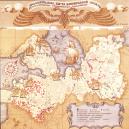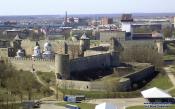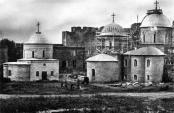|
|
Articles
/
Ivangorod Fortress
Ivangorod FortressThe "quadrangular" fortress was surrounded by the new stone walls and were built the powerful corner towers by Master Vladimir Torgkanom and Marcus Greco in 1507-09. The ruins of this castle are survived until our time inside the new fortifications, which are called the "Castle". The walls and towers of the Big Boyar Town were built at the same time. The Front Town was built from the side of the posad to it. The south-eastern front of the fortress was re-built. After the end of reconstruction of the Ivangorod Fortress was signed the peace treaty with the Grand Principality of Lithuania and with the Livon order in 1509. The Ground (Boyarsky) wall was raised in front of the Front Town in 1556-58 and it completed the formation of the fortress ensemble. In 1583-95 and in 1613-1704 the fortress was under authority by the Swedes. The Fortress was returned to Russia in 1704, during the North War. The architectonical and the archaeological research of the monument were realized by the GP Research Institute SpetsProektRestovratsia (The project leader Haustova I.A.). The archeological digs were relized by the Ioannisyan O.M. in 1978, Petrenko V.P. in 1980-91, Kurbatov A.V. in 1992-95,Lipatov A.A. in 2004. During the archeological dig the stone and wooden buildings, farm buildings, shops, yards, lots of streets, cobbled stone were found. They are dated with the end of the XV - XVI centuries. The Ivangorod historical, architectural and art museum was founded after restoration work in 1980. Authors
Plotkin, Konstantin Moiseyevich
Persons
Grek, Markus
Ioannisyan, Oleg Mikhaylovich Ivan III Vasilyevich, Grand Prince Khaustova, Irena Aleksandrovna Kurbatov, Aleksandr Valentinovich Lipatov, Aleksey Anatolyevich Petrenko, Valery Petrovich Torgkan, Vladimir Zakharyin (Koshkin), Yakov Zakharyevich Geography
Topographical landmarks/Devichya gora
Leningrad Oblast, the/Ivangorod Town Topographical landmarks/Narva River, the Bibliography
Крепость Ивангород. Новые открытия / Сост. М.И. Мильчик. СПб., 1997
Липатов А.А. Археологические исследования на территории Ивангородской крепости в 2004 году // Реликвия. № 3 (10). 2005., С.56-62 Subject Index
Ivangorod History Architecture and Art Museum
The Church of the Dormition of the Mother of God (Ivangorod Town) Mentioned in articles:
|
|














